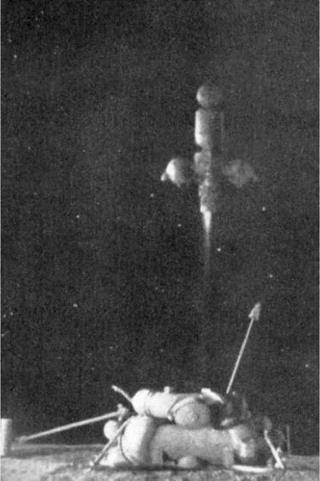RETURN TO THE SEA OF CRISES
 |
For the rest of the series, the Ye-8-5 was redesigned as the Ye-8-5M. The chief improvement was a much more versatile rail-mounted drill for obtaining samples. This drill was a radical improvement on its predecessors which could only reach 30 cm and the new one was able to penetrate to a depth of no less than 2.5 m. This assignment went to the General Construction Design Bureau of Vladimir Barmin (1909-1993). Barmin was a close colleague of Sergei Korolev and a member of the original council
of designers of 1946. He was the constructor of the cosmodromes, a task of enormous proportions involving the heaviest Earth-moving and digging machinery in the world. Now he got the assignment to make precision drilling equipment for use on another world.
It is possible that the Ye-8-5M missions benefited from the studies of the lunar gravitational environment by Luna 19 and 22. This time the target was the old Luna 15 site at 13°N, 62°E in the large Sea of Crises, a region never explored by the Americans.
Three Ye-8-5Ms were launched, in October 1974, October 1975 and August 1976. Luna 23 entered a lunar orbit of 94 x 104 km, 1 hr 57 min, 138° (12° more than Luna 15) on 2nd November 1974, adjusted on the 6th to a pre-descent orbit of 17 x 105 km. When it tried to land in the southern part of the Sea of Crises on its 50th revolution, it was severely damaged in the course of the landing. The soil-collecting gear was wrecked, although the descent stage was able to continue transmissions for a further three days and contact was lost on the 9th November. It was normal for the descent craft to continue to transmit on 922 MHz for this period, though for what purpose is uncertain, except to relay radiation measurements back to Earth.
It may or may not have been open to the Russians to send the empty return craft back to Earth anyway, but the manoeuvre was not attempted. A replacement mission was organized, but the next Luna failed a year later due to block D failing to ignite.
Finally, Luna 24 entered a circular orbit of 115 km, 1 hr 59 min, 120° on 14th August, adjusted to a pre-descent orbit of 120 x 12 km on the 17th, the lowest of any pre-landing orbits. Amateur trackers in Sweden and Florida picked up its signals on 922 MHz for 20 min on every orbit as it transmitted back to Earth. Luna 24 came down in darkness close to the wreckage of Luna 23 and, it is suspected, at the exact place of Luna 15’s targeted spot, 17 km from the small crater Fahrenheit. Touchdown was on 18th August 1976 and all went well this time. As the rotary percussion rig drilled into the soil, the sample was stored in a rubber pipe in such a way as to prevent clogging and compression. The drill brought up samples weighing 170 g in a 2.6 m long core sample and had been modified in order to minimize grains falling off.
Back on Earth, the same amateur trackers were listening in to Luna 24’s liftoff [13]. Normally, the ascent rocket would begin transmission on 183.6 MHz from the moment of engine burn and continue to transmit during the ascent from the moon. Luna 16 and 20 had spent 1.1 and 1.15 days on the moon respectively, so the same could be expected of Luna 24. But this is not what happened. Instead, Luna 24 lifted off early, after only 0.95 days. For the first time, the lunar liftoff took place with the spaceship in line of sight of Yevpatoria at the moment of liftoff. Hitherto, these liftoffs had taken place when the moon rocket was not in sight of Yevpatoria (though it could be seen by an Atlantic tracking ship), but the final stage of the return journey was in line of sight, which was more important. This time, the Russians must have felt so confident with the return trajectory that it could be accomplished out of sight of Yevpatoria. The return flight was longer than the previous missions, 3.52 days and the spacecraft came back into the atmosphere in a curving trajectory around the back side of the Earth like Zonds 6 and 7, with a recovery zone in Siberia, one never used
![]()
|
before or since. The capsule came down in summertime Siberia 200 km southeast of the tundra town of Surgut and no difficulty was reported in finding it.
Samples were again exchanged with the Americans (3 g) and they were dated to 3.3bn years. Some samples also went to Britain. The post-mission report, given in Pravda on 5th September, related how 60 different chemical elements had been found, dark grey to brown in colour. They appear to be laid down in layers.
|
Outcome of sample return missions
|
|
Luna 24 returning to the Earth |
Ye-8 series: scientific outcomes
Characterization of lunar soil from three locations: mare, mare core sample and uplands. Characterization, penetration, measurement of lunar soil in situ from two mare locations (Lunokhod, Lunokhod 2), studying density, strength, composition.
Refinement of lunar and interplanetary gravitational field.
Fluxes in radiation levels on moon and in moon orbit over a period of months. Measurement of precise distances between Earth and the moon.
Characterization of local lunar environment in Bay of Rains, Le Monnier.
Mapping of selected areas on lunar nearside.
Measurement of dust levels over daytime lunar surface.
Discovery of thin sheath of ionized gas over sunlight side of lunar surface.
 |
 Sea of Clouds
Sea of Clouds
Location of Soviet moon probes












